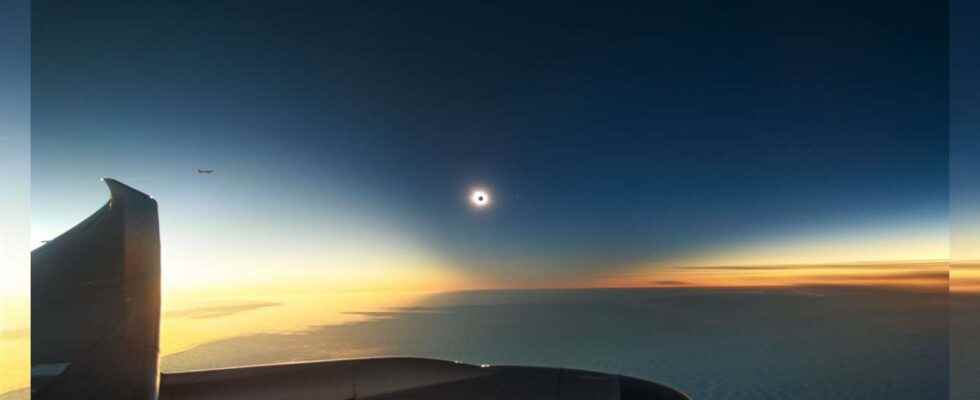It is with the approach of the solstice, at the heart of a polar day during which the Sun never sets, that Antarctica has just experienced a total eclipse. A rare and wonderful moment to relive here in a few images.
A solar eclipse, it is always a special moment. A spectacle all the more marvelous as the eclipse is total. And in this year 2021, the stars promised us one of those rare moments for this Saturday, December 4. At 8:44 a.m. KST, the Sun, Moon, and our Earth found themselves perfectly aligned.
At the heart of polar day, the phenomenon plunged part of theAntarctic and the Southern Ocean in the dark for a few seconds. It hadn’t happened for almost 20 years. Unforgettable seconds, therefore, for those who were lucky enough to be there. Researchers, essentially.
For some, unfortunately, the sky was covered with a coat of clouds. Showing from this total solar eclipse only a marked drop in the brightness. And the probable reactions of some animals living in the region. Flights of petrels, those sea birds with tubular beaks. Or even whale appearances.
A total solar eclipse not to be missed
Others had taken the lead and boarded a plane to fly above the clouds.
Holy shit.
This is a photo from * earlier today * of 2021’s only solar eclipse, which took place over Antarctica.
This pic was taken by Petr Horálek from a Boeing 787 some 12.5 km above the Weddell Sea. At this altitude, totality lasted for ~ 145 seconds.
Look at that shadow pic.twitter.com/7jZO12OKrv
– Paul Byrne (@ThePlanetaryGuy) December 4, 2021
And of course, from space, the spectacle of the moon’s shadow cast on our Earth was beyond measure.
“Saturday morning, the Expedition 66 crew squeezed into the Cupola to check out the total solar eclipse that occurred over Antarctica and the Southern Ocean. Here the moon casts an oblong shadow on the Earth’s surface. It was an incredible sight to behold.”
– Kayla Barron pic.twitter.com/FktW8qsBIU
– NASA Astronauts (@NASA_Astronauts) December 4, 2021
But the magic also worked in full from the ground for the lucky few.
#SolarEclipse December 4, 2021
A total solar eclipse sweeps across Antarctica on December 4, 2021. The instant of greatest eclipse takes place at 07:33 UTC, which is 1:33 am on the morning of December 4 for people in North America (CST). pic.twitter.com/3ARh2i4yIH
– NASA ASTRONOMY (@ NASAASTRONOMIC1) December 3, 2021
The Nasa, she had chosen to broadcast the total solar eclipse from the base ofUnion Glacier, about 1,000 kilometers north of the South Pole. Gorgeous…
4.12.2021 Solar Eclipse from Union Glacier, Antartica. The trip would cost $ 50,000 if you wanted to shoot the Solar Eclipse yourself.
4.12.2021 Güneş Tutulması. Union Glacier, Antarctica’dan görüntüler. Kişisel olarak gidip resim çekmek isteyenler için ücret $ 50,000 ‘mış.@NASApic.twitter.com/9zR40j0Iax
– Evren Sener (@evren_sener) December 4, 2021
And finally, even outside of the totality zone, the show could be … wonderful!
So excited to be starting my year at the South Pole as a winterover for the @SPTelescope with a spectacular partial solar eclipse! On the left is the South Pole Telescope and to the right is the @BICEP_Keck telescope, with the crew from both telescopes silhouetted in between pic.twitter.com/UnnECtbAUJ
– Aman Chokshi (@aman_chokshi) December 6, 2021
And the shadow of the eclipse Antarctic view from orbit: the crew of theISS was also one of the lucky ones.
Пока мы ждем выведение спутников Galileo, представляем фотографии лунной тени с МКС ????
???? «Экипаж МКС – один из тех везунчиков, которым удалось пронаблюдать почти полную фазу этогоиянамелитро. И бонусом – лунная тень на поверхности Земли », – отмечает Петр Дубров. pic.twitter.com/vfhluDn6Oi
– РОСКОСМОС (@roscosmos) December 5, 2021
To admire again a total solar eclipse on the Antarctic side, it will now be necessary to wait until 2039. The next total solar eclipse is scheduled for April 2023. To take advantage of it, it will be necessary this time to put the heading to Australia.
Interested in what you just read?
.
fs3
